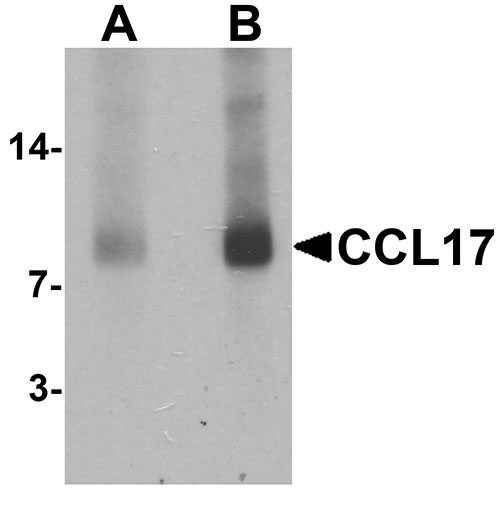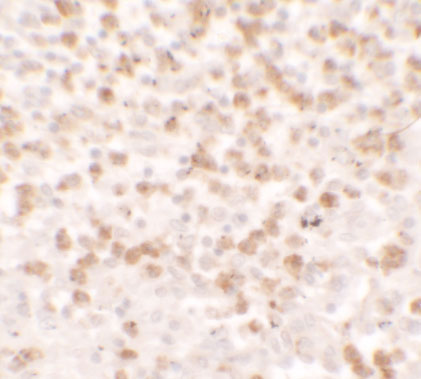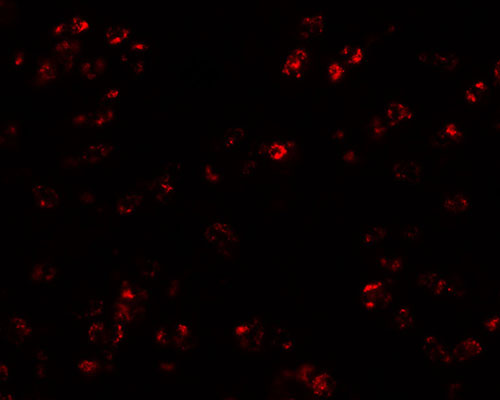CCL17 Antibody
- 产品详情
- 实验流程
- 背景知识
Application
| WB, IF, E, IHC-P |
|---|---|
| Primary Accession | Q92583 |
| Other Accession | NP_002978, 4506829 |
| Reactivity | Human, Mouse, Rat |
| Host | Rabbit |
| Clonality | Polyclonal |
| Isotype | IgG |
| Calculated MW | 10507 Da |
| Concentration (mg/ml) | 1 mg/mL |
| Conjugate | Unconjugated |
| Application Notes | CCL17 antibody can be used for detection of CCL17 by Western blot at 1 - 2 µg/mL. |
| Gene ID | 6361 |
|---|---|
| Other Names | C-C motif chemokine 17, CC chemokine TARC, Small-inducible cytokine A17, Thymus and activation-regulated chemokine, CCL17, SCYA17, TARC |
| Target/Specificity | CCL17; |
| Reconstitution & Storage | CCL17 antibody can be stored at 4℃ for three months and -20℃, stable for up to one year. |
| Precautions | CCL17 Antibody is for research use only and not for use in diagnostic or therapeutic procedures. |
| Name | CCL17 |
|---|---|
| Synonyms | SCYA17, TARC |
| Function | Chemokine, which displays chemotactic activity for T lymphocytes, preferentially Th2 cells, but not monocytes or granulocytes. Therefore plays an important role in a wide range of inflammatory and immunological processes (PubMed:8702936, PubMed:9169480). Acts by binding to CCR4 at T-cell surface (PubMed:10540332, PubMed:9169480). Mediates GM-CSF/CSF2-driven pain and inflammation (PubMed:27525438). In the brain, required to maintain the typical, highly branched morphology of hippocampal microglia under homeostatic conditions. May be important for the appropriate adaptation of microglial morphology and synaptic plasticity to acute lipopolysaccharide (LPS)-induced neuroinflammation (By similarity). Plays a role in wound healing, mainly by inducing fibroblast migration into the wound (By similarity). |
| Cellular Location | Secreted |
| Tissue Location | Constitutively expressed in thymus. Detected at lower levels in the lung, colon and small intestine (PubMed:8702936) Expressed in stimulated peripheral blood mononuclear cells, but not in resting cells (PubMed:8702936). |
For Research Use Only. Not For Use In Diagnostic Procedures.
Provided below are standard protocols that you may find useful for product applications.
BACKGROUND
CCL17 Antibody: CCL17, also known as TARC, binds to chemokine receptors CCR4 and CCR8 and plays important roles in T cell development in thymus as well as in trafficking and activation of mature T cells. CCL17 is secreted from monocyte-derived DCs and endothelial cells and is responsible for selective recruitment and migration of activated Th2 lymphocytes. CCL17 is also required for CCR7 and CXCR4-dependent migration of cutaneous dendritic cells under inflammatory conditions.
REFERENCES
Imai T, Baba M, Nishimura M, et al. The T cell-directed CC chemokine TARC is a highly specific biological ligand for CC chemokine receptor 4. J. Biol. Chem. 1997; 272:15036-42.
Bernardini G, Hedrick J, Sozzani S, et al. Identification of the CC chemokines TARC and macrophage inflammatory protein-1 beta as novel functional ligands for the CCR8 receptor. Eur. J. Immunol. 1998; 28:582-8.
Alferink J, Lieberam I, Reindl W, et al. Compartmentalized production of CCL17 in vivo: strong inducibility in peripheral dendritic cells contrasts selective absence from the spleen. J. Exp. Med. 2003; 197:585-99.
Stutte S, Quast T, Gerbitzki N, et al. Requirement of CCL17 for CCR7 and CXCR4-dependent migration of cutaneous dendritic cells. Proc. Natl. Acad. Sci. USA 2010; 107:8736-41.
终于等到您。ABCEPTA(百远生物)抗体产品。
点击下方“我要评价 ”按钮提交您的反馈信息,您的反馈和评价是我们最宝贵的财富之一,
我们将在1-3个工作日内处理您的反馈信息。
如有疑问,联系:0512-88856768 tech-china@abcepta.com.























 癌症的基本特征包括细胞增殖、血管生成、迁移、凋亡逃避机制和细胞永生等。找到癌症发生过程中这些通路的关键标记物和对应的抗体用于检测至关重要。
癌症的基本特征包括细胞增殖、血管生成、迁移、凋亡逃避机制和细胞永生等。找到癌症发生过程中这些通路的关键标记物和对应的抗体用于检测至关重要。 为您推荐一个泛素化位点预测神器——泛素化分析工具,可以为您的蛋白的泛素化位点作出预测和评分。
为您推荐一个泛素化位点预测神器——泛素化分析工具,可以为您的蛋白的泛素化位点作出预测和评分。 细胞自噬受体图形绘图工具为你的蛋白的细胞受体结合位点作出预测和评分,识别结合到自噬通路中的蛋白是非常重要的,便于让我们理解自噬在正常生理、病理过程中的作用,如发育、细胞分化、神经退化性疾病、压力条件下、感染和癌症。
细胞自噬受体图形绘图工具为你的蛋白的细胞受体结合位点作出预测和评分,识别结合到自噬通路中的蛋白是非常重要的,便于让我们理解自噬在正常生理、病理过程中的作用,如发育、细胞分化、神经退化性疾病、压力条件下、感染和癌症。








